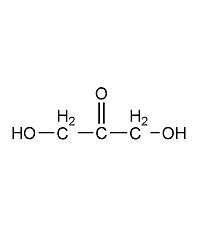
Structural formula
| Business number | 02AU |
|---|---|
| Molecular formula | C3H6O3 |
| Molecular weight | 90.08 |
| label |
1,3-dihydroxy-2-propanone, Propane-1,3-diol-2-one, 1,3-Dihydroxy-2-propanon, 1,3-Dihydroxydimethylketone |
Numbering system
CAS number:96-26-4
MDL number:None
EINECS number:202-494-5
RTECS number:None
BRN number:None
PubChem ID:None
Physical property data
1. Appearance: White powdery crystal with sweet taste
2. Density (g/mL, 25℃): Undetermined
3. Relative vapor density ( g/mL, air=1): Undetermined
4. Melting point (ºC): 75-80
5. Boiling point (ºC, normal pressure): Undetermined
6. Boiling point (ºC, kPa): Undetermined
7. Refractive index: Undetermined
8. Flash point (ºC): Undetermined
9. Specific optical rotation (º): Undetermined
10. Autoignition point or ignition temperature (ºC): Undetermined
11. Vapor pressure (mmHg,ºC ): Undetermined
12. Saturated vapor pressure (kPa, ºC): Undetermined
13. Heat of combustion (KJ/mol): Undetermined
14. Critical temperature (ºC): Undetermined
15. Critical pressure (KPa): Undetermined
16. Log value of oil-water (octanol/water) partition coefficient: Undetermined Determined
17. Explosion upper limit (%, V/V): Undetermined
18. Explosion lower limit (%, V/V): Undetermined
19. Solubility: Easily soluble in organic solvents such as water, ethanol, ether and acetone
Toxicological data
1. Acute toxicity: Rat oral LDLo: 80mg/kg; Rat intraperitoneal LD50: 8750mg/kg; Rabbit intraperitoneal LD: >8mg/kg;
2. Mutagenicity
Mutation of Salmonella typhimurium: 100μg/plate;
Mutation of Salmonella typhimurium: 1mg/plate;
Mutation of Escherichia coli: 3300μmol/L;
DNA repair of Bacillus subtilis: 2ppm
Ecological data
None
Molecular structure data
1. Molar refractive index: 19.04
2. Molar volume (cm3/mol): 70.1
3. Isotonic specific volume (90.2K ): 190.0
4. Surface tension (dyne/cm): 53.7
5. Polarizability (10-24cm3): 7.55
Compute chemical data
1. Reference value for hydrophobic parameter calculation (XlogP): -1.4
2. Number of hydrogen bond donors: 2
3. Number of hydrogen bond acceptors: 3
p>
4. Number of rotatable chemical bonds: 2
5.��Number of isomers: 3
6. Topological molecule polar surface area 57.5
7. Number of heavy atoms: 6
8. Surface charge: 0
9. Complexity: 44
10. Number of isotope atoms: 0
11. Determine the number of atomic stereocenters: 0
12. Uncertain number of atomic stereocenters: 0
13. Determined number of chemical bond stereocenters: 0
14. Uncertain number of chemical bond stereocenters: 0
15. Number of covalent bond units: 1
Properties and stability
None
Storage method
None
Synthesis method
None
Purpose
Used in organic synthesis, biochemical research, substrate for galactose oxidase, and artificial tanning agent.


